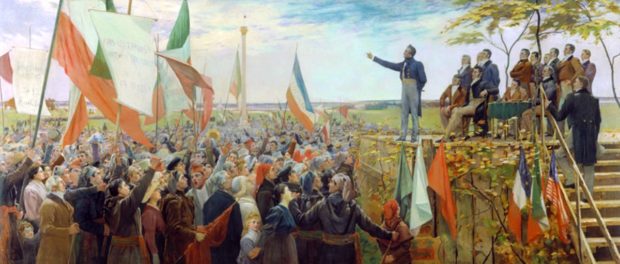1834: The 92 Resolutions & Other Quebec Curios
Part of “Division and Resistance”, 1827-1963
 Papineau speaking to the masses of followers in 1837. Artistic depiction by Charles Alexander Smith, c. 1890. Credit: Musée national des beaux-arts du Québec/Wikimedia Commons.
Papineau speaking to the masses of followers in 1837. Artistic depiction by Charles Alexander Smith, c. 1890. Credit: Musée national des beaux-arts du Québec/Wikimedia Commons.
The violence of the 1837 Rebellions did not come out of nowhere. Prior to the rebellions by force, there were rebellions through the law. In an attempt to get the British government to see things their way, the Parti Patriote would have one last try through means of the 92 Resolutions, a document that listed the grievances of the French-Canadian majority within Lower Canada.
Following a hugely successful election in 1834, the Parti Patriote had a majority of seats in the Lower Canada Assembly, where they were placed at odds with the Tories (the English Party) in the Assembly and more generally with a mostly Anglophone majority nicknamed the Château clique. The Château clique were a mostly English-speaking élite composed of wealthy merchants and businessmen such as John Molson and James McGill who wished to slowly assimilate the French Canadians into a British culture and legal system. Insistent on control, they kept powers such as budgetary control out of the hands of the rabble-rousing Assembly. The Patriotes fought against these enemies, first by pacific means and then later through more violent ones.
Augustin-Norbert Morin was instrumental in drafting the 92 Resolutions shortly after the Patriote’s victory in the Assembly, but it was the ideas of Louis-Joseph Papineau and the Parti Patriote that were the driving force behind the words. Morin accompanied his former mentor Denis-Benjamin Viger to London, where he would present the ideas to the government in the hopes that the government might see if they would allow the proposed changes to be implemented within the colonial government structure of Lower Canada. Contained within the document were demands for the Assembly to have control of the governmental budget as well as a demand for responsible government, a concept where the government is accountable to the people rather than to the higher powers. In Lower Canada’s case, this higher power was eventually King William IV until 1837 and Queen Victoria from 1837 through to Confederation and beyond, English monarchs that had very little connections if any to the French-Canadian people.
However, as it turned out, the 92 Resolutions fell once again on deaf ears. The governor general of Lower Canada, Lord Aylmer, had his own analysis of the matter, worded aptly by historian Hugh Egerton who wrote about these Resolutions from a British perspective at the turn of the nineteenth century: “eleven of them represented the truth; six contained truth mixed with falsehood; sixteen were wholly false; seventeen were doubtful; twelve were ridiculous; seven repetitions; fourteen consisted of abuse, and four were both false and seditious; the remaining five were indifferent”. The British government was inclined to agree, and rejected all of the Resolutions. Politically, this was the last straw for the Patriotes. However, the Rebellions needed popular support as well, and various factors would also contribute to the masses’ support of the Rebellions to come. One of the Patriotes’ most tragic stands would be at Saint Eustache, which we will cover in next week’s post.





